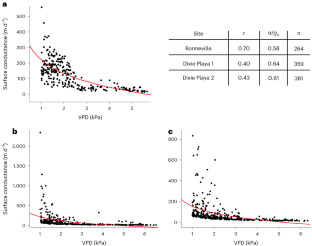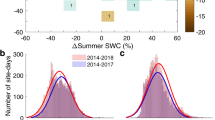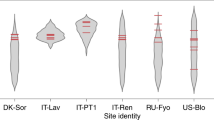Abstract
A growing literature argues that ecosystem-scale evapotranspiration is more sensitive to drying of the atmosphere because of stomatal regulation by plants than to reductions in surface soil moisture. Past studies analysed observations, for which it is difficult to conclusively control for potential relations among plant physiology, measurable state variables such as vapour pressure deficit (VPD) or soil moisture, and ecosystem-scale water flux. Here we analyse natural mechanism-denial experiments at non-vegetated but hydrologically active salt flats. At these sites, any apparent sensitivity of the ecosystem-scale surface conductance (gs, a bulk measure of how the land surface influences evapotranspiration) to VPD cannot be due to stomatal closure. Over the salt flats we find a VPD–gs relation similar to that commonly attributed to stomatal closure, and reproduce similar relations using a parsimonious boundary layer model that excludes plants. We conclude that observational studies probably overstate the sensitivity of ecosystem-scale surface conductance to atmospheric drying and understate the importance of variations in surface soil moisture. This finding has broad implications for future ecosystems, because anthropogenic trends in soil moisture are uncertain and spatially heterogeneous whereas ubiquitous atmospheric drying is expected due to global warming.
This is a preview of subscription content, access via your institution
Access options
Subscribe to this journal
Receive 12 digital issues and online access to articles
$99.00 per year
only $8.25 per issue
Buy this article
- Purchase on Springer Link
- Instant access to full article PDF
Prices may be subject to local taxes which are calculated during checkout






Similar content being viewed by others
Data availability
The Bonneville dataset analysed in the current study is available at https://github.com/Lvargaszeppetello/Surface_Conductance. The Dixie Valley salt flat data are available online at https://waterdata.usgs.gov/monitoring-location/394508118025505/#parameterCode=62968&startDT=2009-05-01&endDT=2010-05-01 and https://waterdata.usgs.gov/monitoring-location/394559118013705/#parameterCode=62968&startDT=2009-05-01&endDT=2010-05-01.
Code availability
All analysis code is available at https://github.com/Lvargaszeppetello/Surface_Conductance.
References
Stephens, G. L. et al. An update on earth’s energy balance in light of the latest global observations. Nat. Geosci. 5, 691–696 (2012).
Penman, H. Natural evaporation from open water, bare soil and grass. Proc. R. Soc. Lond. A Math. Phys. Sci. 193, 120–145 (1948).
Monteith, J. Evaporation and surface temperature. Q. J. R. Meteorol. Soc. 107, 1–27 (1981).
Campbell, G. S. & Norman, J. M. An Introduction to Environmental Biophysics (Springer Science & Business Media, 2000).
Penman, H. The dependence of transpiration on weather and soil conditions. J. Soil Sci. 1, 74–89 (1950).
Thom, A. & Oliver, H. R. On Penman’s equation for estimating regional evaporation. Q. J. R. Meteorol. Soc. 103, 345–357 (1977).
Darwin, F. Ix. Observations on stomata. Philos. Trans. R. Soc. Lond. B Biol. Sci. 63, 589–600 (1898).
Lange, O. L., Lösch, R., Schulze, E. D. & Kappen, L. Responses of stomata to changes in humidity. Planta 100, 76–86 (1971).
Ball, J. T., Woodrow, I. E. & Berry, J. A. in Progress in Photosynthesis Research (ed. Biggins, J.) 221–224 (Springer, 1987).
Turner, N. C., Schulze, E.-D. & Gollan, T. The responses of stomata and leaf gas exchange to vapour pressure deficits and soil water content: I. Species comparisons at high soil water contents. Oecologia 63, 338–342 (1984).
Franks, P., Cowan, I. & Farquhar, G. The apparent feedforward response of stomata to air vapour pressure deficit: information revealed by different experimental procedures with two rainforest trees. Plant Cell Environ. 20, 142–145 (1997).
Medlyn, B. E. et al. Reconciling the optimal and empirical approaches to modelling stomatal conductance. Glob. Chang. Biol. 17, 2134–2144 (2011).
Novick, K. et al. The increasing importance of atmospheric demand for ecosystem water and carbon fluxes. Nat. Clim. Change 6, 1023–1027 (2016).
Kimm, H. et al. Redefining droughts for the U.S. corn belt: the dominant role of atmospheric vapor pressure deficit over soil moisture in regulating stomatal behavior of maize and soybean. Agric. For. Meteorol. 287, 107930 (2020).
Roby, M. C., Scott, R. L. & Moore, D. J. High vapor pressure deficit decreases the productivity and water use efficiency of rain-induced pulses in semiarid ecosystems. J. Geophys. Res. Biogeosci. 125, e2020JG005665 (2020).
Flo, V., Martínez-Vilalta, J., Granda, V., Mencuccini, M. & Poyatos, R. Vapor pressure deficit is the main driver of tree canopy conductance across biomes. Agric. For. Meteorol. 322, 109029 (2022).
Fu, Z. et al. Atmospheric dryness reduces photosynthesis along a large range of soil water deficits. Nat. Commun. 13, 989 (2022).
Mott, K. A. & Parkhurst, D. F. Stomatal responses to humidity in air and helox. Plant Cell Environ. 14, 509–515 (1991).
Buckley, T. N. How do stomata respond to water status? New Phytol. 224, 21–36 (2019).
Grossiord, C. et al. Plant responses to rising vapor pressure deficit. New Phytol. 226, 1550–1566 (2020).
Berg, A., Sheffield, J. & Milly, P. C. Divergent surface and total soil moisture projections under global warming. Geophys. Res. Lett. 44, 236–244 (2017).
Cook, B. I. et al. Twenty-first century drought projections in the CMIP6 forcing scenarios. Earths Future 8, e2019EF001461 (2020).
Roderick, M. L., Greve, P. & Farquhar, G. D. On the assessment of aridity with changes in atmospheric CO2. Water Resour. Res. 51, 5450–5463 (2015).
Swann, A. L., Hoffman, F. M., Koven, C. D. & Randerson, J. T. Plant responses to increasing CO2 reduce estimates of climate impacts on drought severity. Proc. Natl Acad. Sci. USA 113, 10019–10024 (2016).
Berg, A. & McColl, K. No projected global drylands expansion under greenhouse warming. Nat. Clim. Change 11, 331–337 (2021).
Wythers, K., Lauenroth, W. & Paruelo, J. Bare-soil evaporation under semiarid field conditions. Soil Sci. Soc. Am. J. 63, 1341–1349 (1999).
Garcia, C. A. et al. Groundwater discharge by evapotranspiration, Dixie Valley, Westcentral Nevada, March 2009–September 2011. US Geological Survey Professional Paper (USGS, 2015); https://doi.org/10.3133/pp1805
Bowen, B. B., Kipnis, E. L. & Raming, L. W. Temporal dynamics of flooding, evaporation, and desiccation cycles and observations of salt crust area change at the Bonneville salt flats, Utah. Geomorphology 299, 1–11 (2017).
Oren, R. et al. Survery and synthesis of intra- and interspecific variation in stomatal sensitivity to vapour pressure deficit. Plant Cell Environ. 22, 1515–1526 (1999).
Lin, C. et al. Diel ecosystem conductance response to vapor pressure deficit is suboptimal and independent of soil moisture. Agric. For. Meteorol. 250–251, 24–34 (2018).
Kannenberg, S. A. et al. Quantifying the drivers of ecosystem fluxes and water potential across the soil-plant-atmosphere continuum in an arid woodland. Agric. For. Meteorol. 329, 109269 (2022).
McColl, K. A., Salvucci, G. D. & Gentine, P. Surface flux equilibrium theory explains an empirical estimate of water-limited daily evapotranspiration. J. Adv. Model. Earth Syst. 11, 2036–2049 (2019).
Brubaker, K. L. & Entekhabi, D. An analytic approach to modeling land-atmosphere interaction: 1. Construct and equilibrium behavior. Water Resour. Res. 31, 619–632 (1995).
Kim, C. & Entekhabi, D. Feedbacks in the land-surface and mixed-layer energy budgets. Boundary Layer Meteorol. 88, 1–21 (1998).
Raupach, M. R. Equilibrium evaporation and the convective boundary layer. Boundary Layer Meteorol. 96, 107–142 (2000).
Betts, A. K. Idealized model for equilibrium boundary layer over land. J. Hydrometeorol. 1, 507–523 (2000).
Manabe, S. Climate and the ocean circulation: I. The atmospheric circulation and the hydrology of the earth’s surface. Mon. Weather Rev. 97, 739–774 (1969).
Vargas Zeppetello, L., Battisti, D. & Baker, M. The physics of heat waves: what causes extremely high summertime temperatures? J. Clim. 35, 2231–2251 (2022).
Tarin, T., Nolan, R. H., Medlyn, B. E., Cleverly, J. & Eamus, D. Water-use efficiency in a semi-arid woodland with high rainfall variability. Glob. Chang. Biol. 26, 496–508 (2020).
Sulman, B. N. et al. High atmospheric demand for water can limit forest carbon uptake and transpiration as severely as dry soil. Geophys. Res. Lett. 43, 9686–9695 (2016).
Western, A. W., Grayson, R. B. & Blöschl, G. Scaling of soil moisture: a hydrologic perspective. Annu. Rev. Earth Planet. Sci. 30, 149–180 (2002).
Famiglietti, J. S., Ryu, D., Berg, A. A., Rodell, M. & Jackson, T. J. Field observations of soil moisture variability across scales. Water Resour. Res. 44, W01423 (2008).
Gruber, A. et al. Recent advances in (soil moisture) triple collocation analysis. Int. J. Appl. Earth Obs. Geoinf. 45, Part B, 200–211 (2016).
Trugman, A. T., Medvigy, D., Mankin, J. & Anderegg, W. R. Soil moisture stress as a major driver of carbon cycle uncertainty. Geophys. Res. Lett. 45, 6495–6503 (2018).
Feldman, A. F. et al. Remotely sensed soil moisture can capture dynamics relevant to plant water uptake. Water Resour. Res. 59, e2022WR033814 (2023).
McColl, K. A. Practical and theoretical benefits of an alternative to the penman-monteith evapotranspiration equation. Water Resour. Res. 56, e2020WR027106 (2020).
Chen, S., McColl, K. A., Berg, A. & Huang, Y. Surface flux equilibrium estimates of evapotranspiration at large spatial scales. J. Hydrometeorol. 22, 765–779 (2021).
Koster, R. D. et al. On the nature of soil moisture in land surface models. J. Clim. 22, 4322–4335 (2009).
Teuling, A. J., Uijlenhoet, R., Hupet, F., van Loon, E. E. & Troch, P. A. Estimating spatial mean root-zone soil moisture from point-scale observations. Hydrol. Earth Syst. Sci. 10, 755–767 (2006).
Jackson, R. B. et al. A global analysis of root distributions for terrestrial biomes. Oecologia 108, 389–411 (1996).
Lloyd, J., Bloomfield, K., Domingues, T. F. & Farquhar, G. D. Photosynthetically relevant foliar traits correlating better on a mass vs an area basis: of ecophysiological relevance or just a case of mathematical imperatives and statistical quicksand? New Phytol. 199, 311–321 (2013).
Raupach, M. Vegetation-atmosphere interaction and surface conductance at leaf, canopy and regional scales. Agric. For. Meteorol. 73, 151–179 (1995).
Paulson, C. A. The mathematical representation of wind speed and temperature profiles in the unstable atmospheric surface layer. J. Appl. Meteorol. Climatol. 9, 857–861 (1970).
Holtslag, A. & De Bruin, H. Applied modeling of the nighttime surface energy balance over land. J. Appl. Meteorol. Climatol. 27, 689–704 (1988).
Culf, A. D. Equilibrium evaporation beneath a growing convective boundary layer. Boundary Layer Meteorol. 70, 37–49 (1994).
Raupach, M. Combination theory and equilibrium evaporation. Q. J. R. Meteorol. Soc. 127, 1149–1181 (2001).
Acknowledgements
L.R.V.Z. thanks the James S. McDonnell Foundation and the Harvard Center for the Environment for support. K.A.M. acknowledges funding from NSF grant no. AGS-2129576, a Sloan Research Fellowship and the Dean’s Competitive Fund for Promising Scholarship from Harvard University. This work used samples from the traditional lands of the Newe (Western Shoshone) and Goshute peoples. A. Perelet and E. Kipnis provided laboratory assistance for this research. We thank E. Pardyjak and A. Perelet for their analytical assistance. We thank D. Bowling and H. Holmes for sharing their equipment with us. We thank C. A. Garcia for providing the data from the Nevada salt flats. This work was made possible with the support of former BLM West Desert District office staff, including K. Oliver, M. Preston, M. Nelson, C. Johnson, S. Allen, R. Draper, B. White and R. Tea. An NSF Coupled Natural Human Systems Award (no. 1617473) to B.B.B. and a University of Utah Global Change and Sustainability Center Graduate Student Research Grant funded this research. We thank E. Weeks and J. Henry for performing preliminary analyses.
Author information
Authors and Affiliations
Contributions
K.A.M. proposed using salt flat data to address the study’s main question. L.R.V.Z. and K.A.M. designed the research. L.R.V.Z. led the analysis, with contributions from K.A.M. and L.I.T. L.R.V.Z. wrote the first draft, with contributions from K.A.M. J.A.B. and B.B.B. provided the data for the Bonneville salt flats and aided observational analysis. L.R.V.Z., K.A.M., J.A.B., B.B.B., L.I.T., N.M.H., P.G. and P.H. contributed to writing and editing the manuscript.
Corresponding authors
Ethics declarations
Competing interests
The authors declare no competing interests.
Peer review
Peer review information
Nature Water thanks Lucas Cernusak, Russell Scott and the other, anonymous, reviewer(s) for their contribution to the peer review of this work.
Additional information
Publisher’s note Springer Nature remains neutral with regard to jurisdictional claims in published maps and institutional affiliations.
Supplementary information
Supplementary Information
Supplementary Figs. 1 and 2, Tables 1–3 and discussion.
Rights and permissions
Springer Nature or its licensor (e.g. a society or other partner) holds exclusive rights to this article under a publishing agreement with the author(s) or other rightsholder(s); author self-archiving of the accepted manuscript version of this article is solely governed by the terms of such publishing agreement and applicable law.
About this article
Cite this article
Vargas Zeppetello, L.R., McColl, K.A., Bernau, J.A. et al. Apparent surface conductance sensitivity to vapour pressure deficit in the absence of plants. Nat Water 1, 941–951 (2023). https://doi.org/10.1038/s44221-023-00147-9
Received:
Accepted:
Published:
Issue Date:
DOI: https://doi.org/10.1038/s44221-023-00147-9



